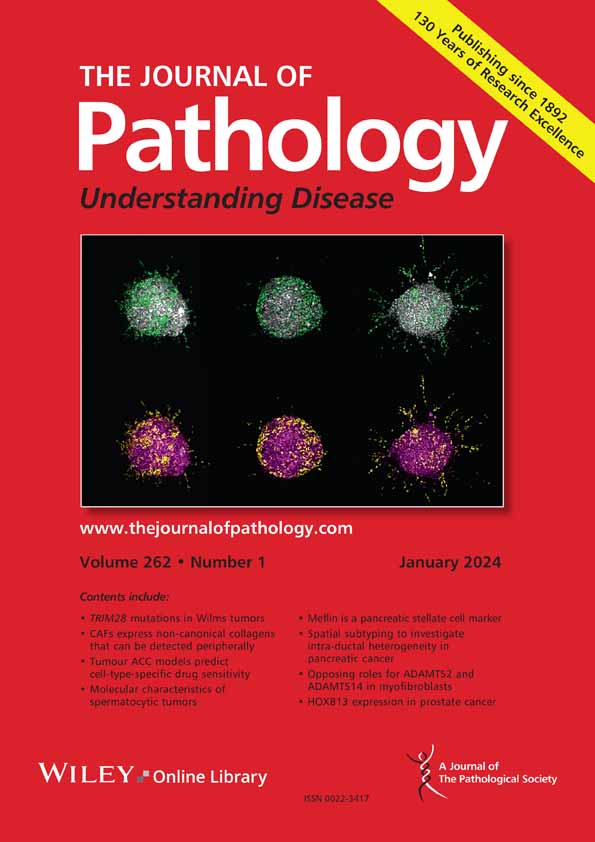Ana-Rita Pedrosa, Alejandro Castillo-Kauil, Yuliia Kravchuk, Louise Reynolds, Bruce Williams, David Moore, Cameron Lang, Srinivas Allanki, Eleni Maniati, Alexandros Hardas, Jozafina Haj, Rebecca Drake, Julie Cleaver, Julie Foster, Jana Kim, Ester Stern, Jane Sosabowski, Gilbert O. Fruhwirth, Erik Sahai, Ori Wald, Kairbaan Hodivala-Dilke
下载PDF
{"title":"具有转移潜力的改进的单灶原发性小鼠肺癌模型的发展和特征。","authors":"Ana-Rita Pedrosa, Alejandro Castillo-Kauil, Yuliia Kravchuk, Louise Reynolds, Bruce Williams, David Moore, Cameron Lang, Srinivas Allanki, Eleni Maniati, Alexandros Hardas, Jozafina Haj, Rebecca Drake, Julie Cleaver, Julie Foster, Jana Kim, Ester Stern, Jane Sosabowski, Gilbert O. Fruhwirth, Erik Sahai, Ori Wald, Kairbaan Hodivala-Dilke","doi":"10.1002/path.6435","DOIUrl":null,"url":null,"abstract":"<p>Lung cancer is the leading cause of cancer-related death globally. To better understand the biology of lung cancer, mouse models have been developed using either tail vein-injected tumour cell lines or genetically modified mice. The current gold-standard models typically present with multiple lung foci. However, although these models are widely used, their correlation with human disease are limited, as early-stage human lung cancer usually presents as a single lesion rather than multiple foci. Additionally, a major challenge of using multifocal lung tumour models is the difficulty in distinguishing primary lung tumours from intrathoracic metastasis and lethal levels of lung congestion before distant metastases develop. Here, we present a refined and detailed surgical method in which murine tumour cells [Lewis lung carcinoma (LLC), alveogenic lung carcinoma (CMT), or <i>Kras/Trp53-</i>KP mutant cells] were injected directly into the left lung lobe of C57BL/6 mice, or, alternatively, adenoviral-Cre or adenoviral-FlpO was administered directly into the left lung lobe of <i>Kras</i><sup><i>LSL-G12D</i></sup>;<i>Trp53</i><sup><i>fl/fl</i></sup> or <i>Kras</i><sup><i>FSF-G12D</i></sup>;<i>Trp53</i><sup><i>frt/frt</i></sup> (KP) mice, respectively. This method generated unifocal primary left lung lobe tumours with traceable spread to local and distant sites. A cross-comparison of the unifocal models described commonalties and differences between LLC, CMT, KP cells, and adenoviral-Cre or -FlpO methods in terms of timings for primary lung tumour growth and traceable spread to local and distant sites, histological analysis of CD3 and CD11b immune cell infiltration, and Picrosirius Red analysis of extracellular matrix complexity. Lastly, the frequency of clinical histopathological features typical of human lung cancer were assessed across the unifocal mouse models to provide a direct comparison with human lung cancer. Overall, this study details a refined and reproducible protocol for intralobular lung injection to generate unifocal lung cancer models that resemble key features of human lung cancer. This approach can be applied to other lung cancer initiation strategies. The cross-comparative histological analysis across the models tested here offers a valuable resource to aid researchers in selecting the most appropriate next-generation unifocal lung cancer models for their specific research needs. © 2025 The Author(s). <i>The Journal of Pathology</i> published by John Wiley & Sons Ltd on behalf of The Pathological Society of Great Britain and Ireland.</p>","PeriodicalId":232,"journal":{"name":"The Journal of Pathology","volume":"266 4-5","pages":"405-420"},"PeriodicalIF":5.2000,"publicationDate":"2025-06-18","publicationTypes":"Journal Article","fieldsOfStudy":null,"isOpenAccess":false,"openAccessPdf":"https://onlinelibrary.wiley.com/doi/epdf/10.1002/path.6435","citationCount":"0","resultStr":"{\"title\":\"Development and characterisation of improved unifocal primary mouse lung cancer models with metastatic potential\",\"authors\":\"Ana-Rita Pedrosa, Alejandro Castillo-Kauil, Yuliia Kravchuk, Louise Reynolds, Bruce Williams, David Moore, Cameron Lang, Srinivas Allanki, Eleni Maniati, Alexandros Hardas, Jozafina Haj, Rebecca Drake, Julie Cleaver, Julie Foster, Jana Kim, Ester Stern, Jane Sosabowski, Gilbert O. Fruhwirth, Erik Sahai, Ori Wald, Kairbaan Hodivala-Dilke\",\"doi\":\"10.1002/path.6435\",\"DOIUrl\":null,\"url\":null,\"abstract\":\"<p>Lung cancer is the leading cause of cancer-related death globally. To better understand the biology of lung cancer, mouse models have been developed using either tail vein-injected tumour cell lines or genetically modified mice. The current gold-standard models typically present with multiple lung foci. However, although these models are widely used, their correlation with human disease are limited, as early-stage human lung cancer usually presents as a single lesion rather than multiple foci. Additionally, a major challenge of using multifocal lung tumour models is the difficulty in distinguishing primary lung tumours from intrathoracic metastasis and lethal levels of lung congestion before distant metastases develop. Here, we present a refined and detailed surgical method in which murine tumour cells [Lewis lung carcinoma (LLC), alveogenic lung carcinoma (CMT), or <i>Kras/Trp53-</i>KP mutant cells] were injected directly into the left lung lobe of C57BL/6 mice, or, alternatively, adenoviral-Cre or adenoviral-FlpO was administered directly into the left lung lobe of <i>Kras</i><sup><i>LSL-G12D</i></sup>;<i>Trp53</i><sup><i>fl/fl</i></sup> or <i>Kras</i><sup><i>FSF-G12D</i></sup>;<i>Trp53</i><sup><i>frt/frt</i></sup> (KP) mice, respectively. This method generated unifocal primary left lung lobe tumours with traceable spread to local and distant sites. A cross-comparison of the unifocal models described commonalties and differences between LLC, CMT, KP cells, and adenoviral-Cre or -FlpO methods in terms of timings for primary lung tumour growth and traceable spread to local and distant sites, histological analysis of CD3 and CD11b immune cell infiltration, and Picrosirius Red analysis of extracellular matrix complexity. Lastly, the frequency of clinical histopathological features typical of human lung cancer were assessed across the unifocal mouse models to provide a direct comparison with human lung cancer. Overall, this study details a refined and reproducible protocol for intralobular lung injection to generate unifocal lung cancer models that resemble key features of human lung cancer. This approach can be applied to other lung cancer initiation strategies. The cross-comparative histological analysis across the models tested here offers a valuable resource to aid researchers in selecting the most appropriate next-generation unifocal lung cancer models for their specific research needs. © 2025 The Author(s). <i>The Journal of Pathology</i> published by John Wiley & Sons Ltd on behalf of The Pathological Society of Great Britain and Ireland.</p>\",\"PeriodicalId\":232,\"journal\":{\"name\":\"The Journal of Pathology\",\"volume\":\"266 4-5\",\"pages\":\"405-420\"},\"PeriodicalIF\":5.2000,\"publicationDate\":\"2025-06-18\",\"publicationTypes\":\"Journal Article\",\"fieldsOfStudy\":null,\"isOpenAccess\":false,\"openAccessPdf\":\"https://onlinelibrary.wiley.com/doi/epdf/10.1002/path.6435\",\"citationCount\":\"0\",\"resultStr\":null,\"platform\":\"Semanticscholar\",\"paperid\":null,\"PeriodicalName\":\"The Journal of Pathology\",\"FirstCategoryId\":\"3\",\"ListUrlMain\":\"https://pathsocjournals.onlinelibrary.wiley.com/doi/10.1002/path.6435\",\"RegionNum\":2,\"RegionCategory\":\"医学\",\"ArticlePicture\":[],\"TitleCN\":null,\"AbstractTextCN\":null,\"PMCID\":null,\"EPubDate\":\"\",\"PubModel\":\"\",\"JCR\":\"Q1\",\"JCRName\":\"ONCOLOGY\",\"Score\":null,\"Total\":0}","platform":"Semanticscholar","paperid":null,"PeriodicalName":"The Journal of Pathology","FirstCategoryId":"3","ListUrlMain":"https://pathsocjournals.onlinelibrary.wiley.com/doi/10.1002/path.6435","RegionNum":2,"RegionCategory":"医学","ArticlePicture":[],"TitleCN":null,"AbstractTextCN":null,"PMCID":null,"EPubDate":"","PubModel":"","JCR":"Q1","JCRName":"ONCOLOGY","Score":null,"Total":0}
引用次数: 0
引用
批量引用




 求助内容:
求助内容: 应助结果提醒方式:
应助结果提醒方式:


